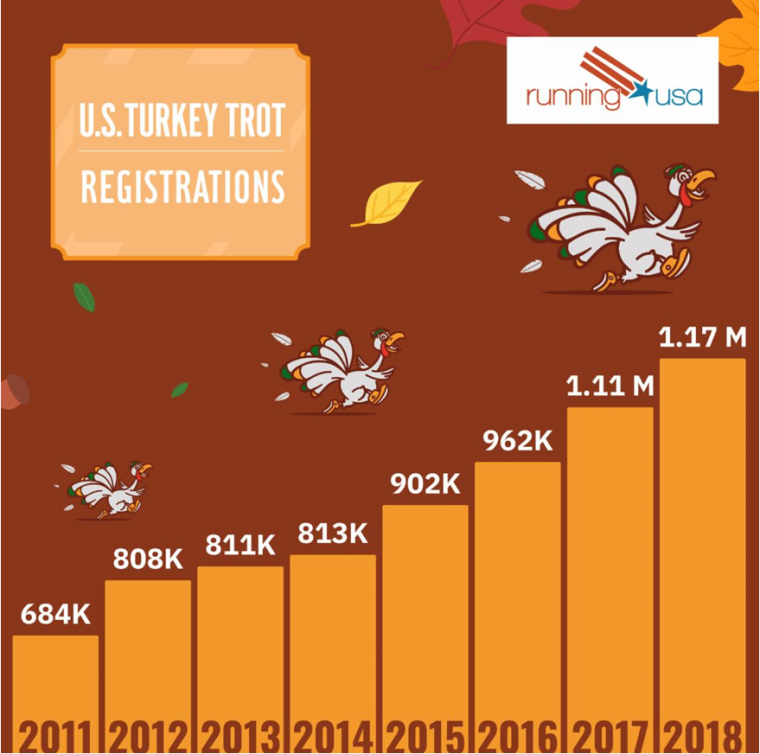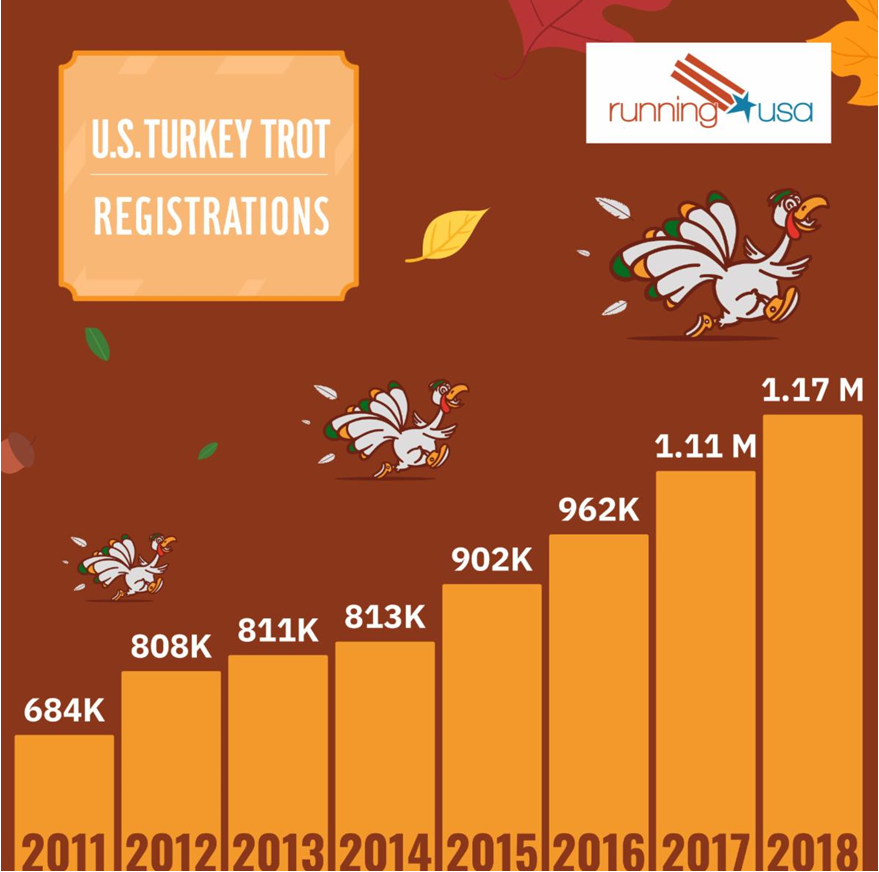

Traditionally, turkey trots have been one of the biggest cash cows of Thanksgiving, according to Running USA, which in a 2018 study (the last one made on the subject), noted that nearly 1.2 million runners were participating.
In a typical year, more than 1,000 races are planned for the big day – as opposed to a typical Thursday, when fewer than a dozen were scheduled. (The weekend after Thanksgiving also shows a lull in 5K participation).
But if Thanksgiving races are a good bet, it’s because an estimated 46.9 million people are usually traveling for the holiday, according to CNN, and many of those will be looking for a way to stay healthy in the towns they’re visiting.
This year, USA TODAY has a forecast for even more travel on the roads and in the air, despite the pandemic. In the article, travel expert Amanda Norcross noted that she expects an increase in travel this holiday season, despite fewer people traveling overall.
“Many will be traveling to see family and friends for the first time since quarantine began, and are likely to score lower airfares as cash-strapped airlines compete to offer the best deals,” Norcross says.
According to a poll quoted in the article, 39 percent say they plan to travel during the holidays this year. However, 21 percent have said they do not plan to travel, though in a typical year, they would. About 50 percent plan to fly over Thanksgiving and 75 percent say they will for the December holidays.
And that correlates with a continued demand for live events. Some live events are planned, and the largest of these, according to the following information from Running USA, might be the Drumstick Dash, scheduled to take place in Indianapolis, with a reduced participant volume. The race has permission to run two separate heats, at 8am and 10am, capped at 3,000 participants each for a total of 6,000 runners, Runners will have a 30 minute window to leave the start line when they feel comfortable, providing for spacing. And the race will be timed as usual.
“Knowing how things typically land, we have accounted for each person having 12 square feet of space, if everyone was distanced equally. We wanted to make sure that nobody would ever find themselves in a spot where they were surrounded by people and could not move or get out of there,” said Brian Crispin, Director of Marketing and Corporate Engagement for Wheeler Mission, the beneficiary for the event.
A key aspect of the plan is to limit points of contact between runners and other runners or spectators, volunteers or vendors. As such, there will be no pre-race concert this year, no water stations on the course, no in-person expo, no packet pickup and no post-race festivities. Packets including race shirts will be sent to every runner at no additional charge. And in-person runners will be handed a grab-and-go snack pack as they depart the finish line area.
There is also a virtual event option for those who prefer to run at home, which has already seen a 300 percent jump in registrations compared to previous years. And a virtual expo, powered by Eventhub, will replace the popular in-person expo experience, as well as offering interactive programming and media for participants. The race’s sponsorship base of 45+ local companies remains strong.
For the full story on the Drumstick Dash, click here.
Other in-person races are, of course, still being offered this year, with Oklahoma being one setting. Events include the Piedmont Turkey Trot (costumes welcome) and the Guymon Gobbler Gallop. The North Dakota Cystic Fibrosis Association is also planning a live Turkey Trot, as is Bismarck, North Dakota. Elsewhere in the U.S., the Florida Turkey Trot is being marketed as the “only in-person event in the Tampa Bay area.”
Some live events have changed in format to accommodate the situation, such as the Black Hills Turkey Trot, which will run on a specific course – but will not have a mass start.
And turkey trots aren’t the only in-person events being held. In Dumfries, Virginia, the Prince William 5v5 Turkey Shootout Soccer Tournament is taking registrations for teams in every age group, from children through adults. In Mobile, the Lyons Park Turkey Day Tennis Classic was actually held in advance of the big day – but it still ran.
Unfortunately, live events are thin on the ground this year. The virtual turkey trot, of course, is, of course, a popular alternative. Butler County, Pennsylvania offers its version of the event, in conjunction with its YMCA. (Bonus round: All participants get a T-shirt). The Albuquerque Turkey Trot, long a local tradition, has also gone virtual. So have America’s Turkey Trot (marketed as the largest community turkey trot in history, and open to all event owners), the Arkansas FFA Turkey Trot, the Auburn Turkey Trot (in Washington State) and a host of others, the Bainbridge Island Turkey Trot – and far too many others to mention. You can look them up here.
Tough Mudder has entered the fray with its Tough Turkey, including The Gobbler Family Challenge, Tough Turkey 5K and Toughest Turkey (including obstacles found in the backyard).
Running USA has also started a #GiveThanksAndGetMoving campaign, a monthlong campaign with each week devoted to a different aspect of the Thanksgiving feast (for example, the first week dealt with “the appetizer course” of pre-activity stretches.
After all, there are always these numbers:
46 Million: The estimated number of turkeys eaten in the U.S. in 2012 (CNN)
4,500: The number of calories the average person expects to consume on Thanksgiving, and
45: Percentage of those calories that come straight from fat (thank you, ABC News, for both of those incredibly depressing statistics)
But wait – there’s more, according to the Bob Vila site:
- Americans consume 250 million pounds of potatoes (all varieties)—and buy $3.7 million dollars worth of deli mashed potatoes—during Thanksgiving.
- A total of 77 million pounds of ham is eaten
- 57 million pounds of sweet potatoes are sold, and
- 28 million pies

